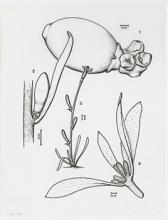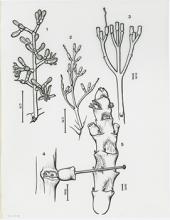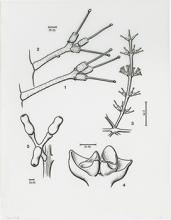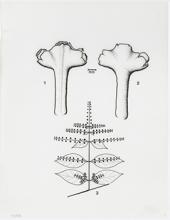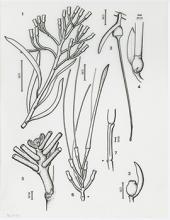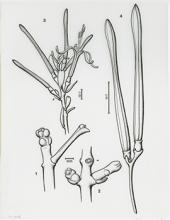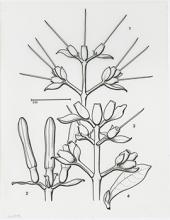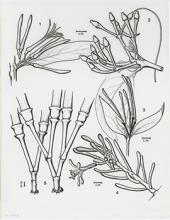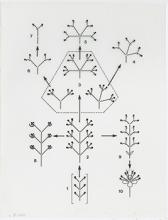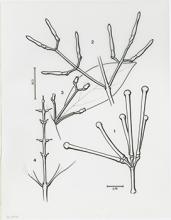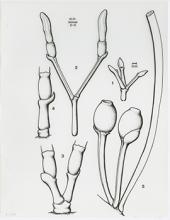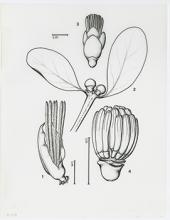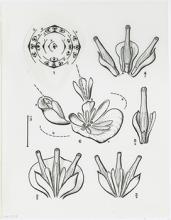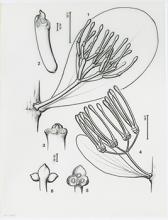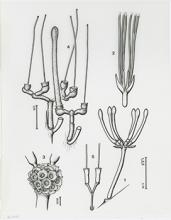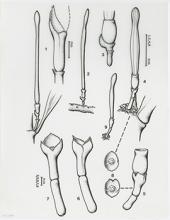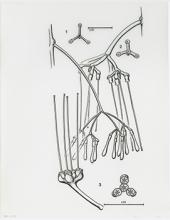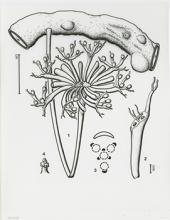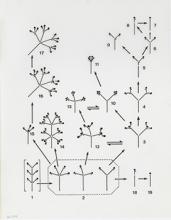Accession Number: 8091.02
Image (click image to view):
Title: Fig. 2. Cladocolea
Taxon: Cladocolea biflora Kuijt; C. dimorpha Kuijt; C. clandestina (Martius) Kuijt; C. grahamii Tieghem; C. inconspicua (Bentham) Kuijt, Loranthaceae
Description: Cladocolea. 1. C. biflora. 2, 3. C. dimorpha, primary and secondary inflorescences, respectively. 4. C. clandestina. 5. C. grahamii. 6. C. inconspicua.
Dimensions (cm): 28 x 21.5
Date of Execution: ca.1981
Published: Kuijt, Job. 1981. Inflorescence morphology of Loranthaceae – an evolutionary synthesis. Blumea 27: 1-73 (p. 48).
Accession Number: 8091.03
Image (click image to view):
Title: Fig. 3. Cladocolea
Taxon: Cladocolea biflora Kuijt; C. dimorpha Kuijt; C. clandestina (Martius) Kuijt; C. grahamii Tieghem; C. inconspicua (Bentham) Kuijt, Loranthaceae
Description: Cladocolea. 1. C. cupulata. 2. C. inorna. 3. C. gracilis. 4. C. microphylla.
Dimensions (cm): 28 x 21.5
Date of Execution: ca.1981
Published: Kuijt, Job. 1981. Inflorescence morphology of Loranthaceae – an evolutionary synthesis. Blumea 27: 1-73 (p. 49).
Accession Number: 8091.04
Image (click image to view):
Title: Fig. 4. Struthanthus and Oryctanthus
Taxon: Struthanthus marginatus (Desrousseaux) G. Don; S. deppeanus (Chamisso & Schlechtendal) G. Don; S. liebmanni Tieghem; S. polystachyus (Ruiz & Pavon) G. Don; Oryctanthus asplundii Kuijt, Loranthaceae
Description: Struthanthus and Oryctanthus. 1. S. marginatus. 2. S. deppeanus. 3. S. liebmanni, tip of raceme. S. polystachyus, sessile triad. 5. O. asplundii.
Dimensions (cm): 28 x 21.5
Date of Execution: ca.1981
Published: Kuijt, Job. 1981. Inflorescence morphology of Loranthaceae – an evolutionary synthesis. Blumea 27: 1-73 (p. 50).
Accession Number: 8091.05
Image (click image to view):
Title: Fig. 5. Struthanthus
Taxon: Struthanthus papillosus Standley & Steyermark; S. flexilis (Rusby) Kuijt; S. condensatus Kuijt; S. costaricensis Standley, Loranthaceae
Description: Struthanthus. 1, 2. S. papillosus, two triads from upper and lower portion of raceme, respectively, showing different positions of bract. 3. S. flexilis. 4. S. condensatus, entire inflorescence. 5. S. costaricensis, showing postflorally expanded pedicels and peduncle of triad.
Dimensions (cm): 28 x 21.5
Date of Execution: ca.1981
Published: Kuijt, Job. 1981. Inflorescence morphology of Loranthaceae – an evolutionary synthesis. Blumea 27: 1-73 (p. 51).
Accession Number: 8091.06
Image (click image to view):
Title: Fig. 6. Struthanthus, Dendropemon, Phthirusa, and Oryctina
Taxon: Struthanthus panamensis (Rizzini) Barlow & Wiens; Dendropemon constantiae Krug & Urban; Phthirusa robusta Rusby; Phthirusa pyrifolia Eichler; Oryctina subaphylla Rizzini, Loranthaceae
Description: Struthanthus, Dendropemon, Phthirusa, and Oryctina. 1. Struthanthus panamensis, monad. 2. Dendropemon constantiae, monad. 3. Phthirusa robusta. 4, 5. Phthirusa pyrifolia, triad and pentad, adaxial views. 6, 7. Oryctina subaphylla, portion of old spike and flower bud.
Dimensions (cm): 28 x 21.5
Date of Execution: ca.1981
Published: Kuijt, Job. 1981. Inflorescence morphology of Loranthaceae – an evolutionary synthesis. Blumea 27: 1-73 (p. 52).
Accession Number: 8091.07
Image (click image to view):
Taxon: Phthirusa Martius; P. retroflexa (Ruiz & Pavon) Kuijt, Loranthaceae
Description: Phthirusa. 1, 2. Phthirusa sp., triad seen from below and above, respectively, to show fusion of bracts and bracteoles. 3. P. retroflexa, diagrammatic representation of compound inflorescence. Each solid circle represents a triad.
Dimensions (cm): 28 x 21.5
Date of Execution: ca.1981
Published: Kuijt, Job. 1981. Inflorescence morphology of Loranthaceae – an evolutionary synthesis. Blumea 27: 1-73 (p. 53).
Accession Number: 8091.08
Image (click image to view):
Taxon: Tripodanthus flagellaris Tieghem; Tristerix longebracteatus (Desrousseaux) Barlow & Wiens; T. grandiflorus (Ruiz & Pavon) Barlow & Wiens; T. tetrandrus Martius; T. aphyllus (Miers ex de Candolle) Barlow & Wiens, Loranthaceae
Description: Tripodanthus and Tristerix. 1. Tripodanthus flagellaris. 2, 3. Tristerix longebracteatus, monads. 4. Tristerix grandiflorus, monad showing rare bracteole. 5. Tristerix tetrandrus, inflorescence with all monads partly cut away, showing aborted apex. 6, 7. Tristerix aphyllus, inflorescence and monad, the latter showing persistent apical bud (arrow), the former showing position of lateral inflorescence bud (arrow).
Dimensions (cm): 28 x 21.5
Date of Execution: ca.1981
Published: Kuijt, Job. 1981. Inflorescence morphology of Loranthaceae – an evolutionary synthesis. Blumea 27: 1-73 (p. 54).
Accession Number: 8091.09
Image (click image to view):
Title: Fig. 9. Tristerix and Ligaria
Taxon: Tristerix aphyllus (Miers ex de Candolle) Barlow & Wiens; Ligaria Tieghem, Loranthaceae
Description: Tristerix and Ligaria. 1. T. aphyllus, tip of old inflorescences (upper monad peduncle extending to the right), the apex beginning to proliferate. 2. Same, basal portion of old inflorescence (lowest monad scar at arrow), showing proliferation at two lateral buds. 3. Ligaria, flowering branch. The arrow indicates a small leaf on the floral pedicel. 4. Same, 2-flowered inflorescence, the flower on the right being the terminal one, the other lateral and in the axil of a bract. The terminal flower is supported by 4 fused bracts, three of which are here visible.
Dimensions (cm): 28 x 21.5
Date of Execution: ca.1981
Published: Kuijt, Job. 1981. Inflorescence morphology of Loranthaceae – an evolutionary synthesis. Blumea 27: 1-73 (p. 55).
Accession Number: 8091.10
Image (click image to view):
Title: Fig. 10. Gaiadendron: variation of the inflorescence tips in Costa Rica.
Taxon: Gaiadendron G. Don, Loranthaceae
Description: Gaiadendron: variation of the inflorescence tips in Costa Rica. 1. Sequence: triad-bracteolate monad-apical flower. 2. Sequence: triad (out of view)-ebracteolate monad-apical flower, the latter with two additional bracts. 3. Sequence: triad-bracteolate monad-ebracteolate monad-apical flower. 4. Young triad, showing bracteoles covering the flowers.
Dimensions (cm): 28 x 21.5
Date of Execution: ca.1981
Published: Kuijt, Job. 1981. Inflorescence morphology of Loranthaceae – an evolutionary synthesis. Blumea 27: 1-73 (p. 56).
Accession Number: 8091.11
Image (click image to view):
Title: Fig. 11. Psittacanthus
Taxon: Psittacanthus ramiflorus G. Don; P. schiedeanus (Chamisso & Schlechtendal) G. Don; P. sonorae (s. Watson) Kuijt; P. pusillus Kuijt, Loranthaceae
Description: Psittacanthus. 1. P. ramiflorus. 2. P. schiedeanus. 3. P. schiedeanus, teratological inflorescence, the leaf on the right subtending three pedicellate flowers (pedicels in black). 4. P. sonorae. 5. P. pusillus, two inflorescence forms.
Dimensions (cm): 28 x 21.5
Date of Execution: ca.1981
Published: Kuijt, Job. 1981. Inflorescence morphology of Loranthaceae – an evolutionary synthesis. Blumea 27: 1-73 (p. 57).
Accession Number: 8091.12
Image (click image to view):
Title: Fig. 12. Psittacanthus
Taxon: Psittacanthus palmeri (watson) Barlow & Wiens; P. cucullaris (Lamarck) G. Don, Loranthaceae
Description: Psittacanthus. 1. P. palmeri, one missing flower for each of the two leaves on the left is indicated by a dotted line. 2 through 6. P. cucullaris. 2. Two very young triads at the tip of the inflorescence, the bracteoles still being no more than half as large as the bracts. 3. A somewhat later stage, from lower on the same inflorescence, the two bracteoles approaching the bract in size. 4. A still later stage, the cupular form of the bracteoles and the cupule of the median flower (left) being recognizable, and the tips of the three buds emerging. 5. Mature triad of form with small bract. 6. Large-bracted triad in fruit.
Dimensions (cm): 28 x 21.5
Date of Execution: ca.1981
Published: Kuijt, Job. 1981. Inflorescence morphology of Loranthaceae – an evolutionary synthesis. Blumea 27: 1-73 (p. 58).
Accession Number: 8091.13
Image (click image to view):
Title: Fig. 13. Schematic representation of the presumed evolution of the inflorescences of Psittacanthus and Aetanthus
Taxon: Psittacanthus Martius; Aetanthus Engler, Loranthaceae
Description: Schematic representation of the presumed evolution of the inflorescences of Psittacanthus and Aetanthus; see text for details. The simple raceme in brackets (1) represents the presumptive ancestral condition.
Dimensions (cm): 28 x 21.5
Date of Execution: ca.1981
Published: Kuijt, Job. 1981. Inflorescence morphology of Loranthaceae – an evolutionary synthesis. Blumea 27: 1-73 (p. 59).
Accession Number: 8091.14
Image (click image to view):
Title: Fig. 14. Alepis, Ileostylus, Peraxilla, Trilepidea, and Tupeia
Taxon: Alepis Tieghem; Ileostylus Tieghem; Peraxilla tetrapetala (Linnaeus f.) Tieghem; Trilepidea Tieghem; Tupeia Chamisso & Schlechtendal, Loranthaceae
Description: Alepis, Ileostylus, Peraxilla, Trilepidea, and Tupeia. 1. Alepis, pedicel of monad near tip of raceme, showing apparent lack of bracts and bracteoles. 2. Same, lowest part of raceme, showing both bract scar (black) below pedicel and minute bracteole scars, in prophyllar positions, on top of pedicel. 3. Same as 2, view of pedicel from above, showing flower scar flanked by both bracteole scars. 4. Ileostylus, male, lower triad. 5. Peraxilla tatrapetala, aborted branch tip flanked by two leaves which subtend swollen axillary cushions. 6. Same, with one pedicellate flower in each leaf axil ensheathed by the fissured crater. Note bracteole-like lobes at tip of pedicels. 7. Same, large peduncle of inflorescence which has borne several flowers. 8. Trilepidea. 9. Tupeia, female. A rather condensed, purely monadic inflorescence; flowers are not subtended by foliage leaves, as the latter have separate axillary buds (not visible in figure).
Dimensions (cm): 28 x 21.5
Date of Execution: ca.1981
Published: Kuijt, Job. 1981. Inflorescence morphology of Loranthaceae – an evolutionary synthesis. Blumea 27: 1-73 (p. 60).
Accession Number: 8091.15
Image (click image to view):
Title: Fig. 15. Globimetula, Helixanthera, and Loranthus.
Taxon: Globimetula braunii (Engler) Danser; Helixanthera ligustrina Danser; Loranthus europaeus Jacquin, Loranthaceae
Description: Globimetula, Helixanthera, and Loranthus. 1. Globimetula braunii. 2. Helixanthera ligustrina. 3. Same. Primary raceme 2-flowered, with two secondary racemes each reduced to a 1-flowered condition. 4. Loranthus europaeus, female, with terminal flower.
Dimensions (cm): 28 x 21.5
Date of Execution: ca.1981
Published: Kuijt, Job. 1981. Inflorescence morphology of Loranthaceae – an evolutionary synthesis. Blumea 27: 1-73 (p. 61).
Accession Number: 8091.16
Image (click image to view):
Taxon: Lysiana subfalcata (Hooker) Barlow; L. linearifolia Tieghem; 4. L. exocarpi Tieghem, Loranthaceae
Description: Lysiana. 1. L. subfalcata, 3-rayed umbel. 2. L. linearifolia, 2-rayed umbel. 3, 4. L. exocarpi, 2- and 1-rayed ‘umbel’, the peduncle invisible in the figure. Note also the fringed top of the pedicel.
Dimensions (cm): 28 x 21.5
Date of Execution: ca.1981
Published: Kuijt, Job. 1981. Inflorescence morphology of Loranthaceae – an evolutionary synthesis. Blumea 27: 1-73 (p. 62).
Accession Number: 8091.17
Image (click image to view):
Title: Fig. 17. Tolypanthus, Diplatia, and Dicymanthes
Taxon: Tolypanthus involucratus Blume; Diplatia furcata Barlow; Dicymanthes seriata Danser, Loranthaceae
Description: Tolypanthus, Diplatia, and Dicymanthes. 1. Tolypanthus involucratus, seen from aside and from above. 2. Diplatia furcata, entire inflorescence and one with the nearest bract removed (broken line) to show triad with bracteoles. 3. Dicymanthes seriata, old inflorescences and one inflorescence scar on internode of stem.
Dimensions (cm): 28 x 21.5
Date of Execution: ca.1981
Published: Kuijt, Job. 1981. Inflorescence morphology of Loranthaceae – an evolutionary synthesis. Blumea 27: 1-73 (p. 63).
Accession Number: 8091.18
Image (click image to view):
Title: Fig. 18. Distrianthes and Lepeostegeres
Taxon: Distrianthes molliflora Danser; Lepeostegeres Blume, Loranthaceae
Description: Distrianthes and Lepeostegeres. 1. Distrianthes molliflora, inflorescence on epicortical root. 2. Lepeostegeres sp., showing two recently emerged young capitula flanking the aborted shoot apex. 3. Same, inflorescence almost expanded. 4. Lepeostegeres sp., mature inflorescence with all bracts removed.
Dimensions (cm): 28 x 21.5
Date of Execution: ca.1981
Published: Kuijt, Job. 1981. Inflorescence morphology of Loranthaceae – an evolutionary synthesis. Blumea 27: 1-73 (p. 64).
Accession Number: 8091.19
Image (click image to view):
Taxon: Cyne alternifolia Danser; C. banahaensis Danser, Loranthaceae
Description: Cyne. 1. C. alternifolia, leafless branch with two large axillary cushions flanking aborted apex, and with two inflorescence scars below; a sessile capitulum drawn to the right. 2. C. banahaensis, nearly mature capitulum removed from its corky capsule (broken line). 3. The same capitulum as seen from below. 4. The same capitulum as seen from above, with all flowers removed to show bracts and bracteoles of all four triads (The same median flower of one inner triad is labelled with m in each of Figs. 2, 3, and 4. In the latter two figures, the extent of the two outer triads is indicated by means of a dotted line).
Dimensions (cm): 28 x 21.5
Date of Execution: ca.1981
Published: Kuijt, Job. 1981. Inflorescence morphology of Loranthaceae – an evolutionary synthesis. Blumea 27: 1-73 (p. 65).
Accession Number: 8091.20
Image (click image to view):
Title: Fig. 20. Thaumasianthes amplexifolius
Taxon: Thaumasianthes Danser, Loranthaceae
Description: Thaumasianthes amplexifolius. 1. Diagram of the inflorescence, the lettering of parts corresponding to that in other figures. Structures subtended by bracts i and j were absent. 2. Triad a, seen from adaxial side. For the sake of clarity, flowers are indicated in bud; in reality, they were in anthesis. 3. Same, abaxial side. 4. Triad f, seen from adaxial side, the two lateral flowers moved aside as shown by dotted line. 5. ‘Terminal’ flower (see text). 6. Some of the major, lower organs of the inflorescence, the lettering corresponding to that in Fig. 20-1. The monad complex subtended by bract g displaced upward slightly for clarity of representation. The two broken, straight lines indicate a single flower each, the curved ones bracts.
Dimensions (cm): 28 x 21.5
Date of Execution: ca.1981
Published: Kuijt, Job. 1981. Inflorescence morphology of Loranthaceae – an evolutionary synthesis. Blumea 27: 1-73 (p. 66).
Accession Number: 8091.21
Image (click image to view):
Taxon: Amyema clavipes Danser; A. lucasii (Blakely) Danser, Loranthaceae
Description: Amyema. 1. A. clavipes, triads with only lateral flowers pedicellate. 2. Same, triad peduncle, showing position of the three flower/pedicel scars. 3. Same, aborted apex of umbel surrounded by triad scars. 4. A. lucasii, triads with all three flowers sessile. 5, 6. Same, triad seen from above and below, respectively, the flowers removed.
Dimensions (cm): 28 x 21.5
Date of Execution: ca.1981
Published: Kuijt, Job. 1981. Inflorescence morphology of Loranthaceae – an evolutionary synthesis. Blumea 27: 1-73 (p. 67).
Accession Number: 8091.22
Image (click image to view):
Taxon: Amyema maidenii (Blakely) Barlow; A. tetrapetala (Danser) Barlow; A. strongylophylla Danser; A. gibberula (Tate) Danser; A. seemeniana (K. Schumann) Danser, Loranthaceae
Description: Amyema. 1. A. maidenii, inflorescence of two sessile triads. 2. A. tetrapetala, as in A. maidenii. 3. A. strongylophylla, many-rayed umbel of triads, the basal portions of two shown. 4. A. gibberula, inflorescences with two dyads and one dyad. 5. A. seemeniana, inflorescence a 2-rayed simple umbel.
Dimensions (cm): 28 x 21.5
Date of Execution: ca.1981
Published: Kuijt, Job. 1981. Inflorescence morphology of Loranthaceae – an evolutionary synthesis. Blumea 27: 1-73 (p. 68).
Accession Number: 8091.23
Image (click image to view):
Title: Fig. 23. Amyema and Sogerianthe: unifloral types
Taxon: Amyema finisterrae Danser; A. hastifolia (Ridley) Danser; Sogerianthe sogerensis (S. Moore) Danser, Loranthaceae; S. versicolor Danser, Loranthaceae
Description: Amyema and Sogerianthe: unifloral types. 1. A. finisterrae. 2. A. hastifolia, root-borne flower. 3. A. hastifolia, enlarged. 4. S. sogerensis (note flower zone). 5 Same, showing split second bract. 6, 7. Same, showing two views of the common 2-lobed condition of the second bract. 8. Same, views from above of bracts of Fig. 23-4 (above) and 23-5 (below). 9. S. versicolor.
Dimensions (cm): 28 x 21.5
Date of Execution: ca.1981
Published: Kuijt, Job. 1981. Inflorescence morphology of Loranthaceae – an evolutionary synthesis. Blumea 27: 1-73 (p. 69).
Accession Number: 8091.24
Image (click image to view):
Taxon: Amyema pendula (Sprengel) Tieghem; A. fitzgeraldii (Blakely) Danser, Loranthaceae
Description: Amyema. 1. A. pendula, triadic type, with single triad seen from below. 2. Same, tetradic type, with single tetrad seen from below. 3. A. fitzgeraldii, with view from above on the right.
Dimensions (cm): 28 x 21.5
Date of Execution: ca.1981
Published: Kuijt, Job. 1981. Inflorescence morphology of Loranthaceae – an evolutionary synthesis. Blumea 27: 1-73 (p. 70).
Accession Number: 8091.25
Image (click image to view):
Title: Fig. 25. A. dilatipes
Taxon: Amyema dilatipes Barlow, Loranthaceae
Description: A. dilatipes. 1. Inflorescence attached to epicortical root; one scar, and three young inflorescences still within capsules are also visible. For the sake of clarity, a number of tetrads have been cut away, leaving only the base of peduncles. 2. Tetrad enlarged, with flowers removed. The forked organ on the right is the primary bract. 3. Diagrammatic representation of Fig. 25-2. The primary bract indicated by a white crescent, other bracts in black. 4. Aborted apex of compound umbel.
Dimensions (cm): 28 x 21.5
Date of Execution: ca.1981
Published: Kuijt, Job. 1981. Inflorescence morphology of Loranthaceae – an evolutionary synthesis. Blumea 27: 1-73 (p. 71).
Accession Number: 8091.26
Image (click image to view):
Title: Fig. 26. Amyema and related genera: schematic representation of the presumed evolution of inflorescences
Taxon: Amyema Tieghem; A. quandang Tieghem; A. gibberula (Tate) Danser; A. seemeniana (K. Schumann) Danser; A. hilliana (Blakely) Danser; A. maidenii (Blakely) Barlow; A. tetrapetala (Danser) Barlow; A. linophylla (Fenzl) Tieghem; A. clavipes Danser; A. fitegeraldii (Blakely) Danser; A. dilatipes Barlow; A. miquelii (Miquel) Tieghem; A. pendula (Sprengel) Tieghem; Sogerianthe Danser; Sogerianthe versicolor Danser; Dicymanthes Danser; Dactyliophora Tieghem, Loranthaceae
Description: Amyema and related genera: schematic representation of the presumed evolution of inflorescences. See text for details. 1. Presumed ancestral raceme of monads with recaulescent bracts. 2. Simple umbels with two or more rays. 3. Two-rayed umbel of triads with sessile median flower and pedicellate lateral ones, e.g., A. quandang. 4. Two-rayed umbel of dyads, as in some A. gibberula. 5. One-rayed umbel with dyad, as in most A. gibberula. 6. Simple, two-rayed umbel, as in A. seemeniana. 7. One-flowered inflorescence with bracteate, flower and inarticulate pedicel, e.g., Sogerianthe versicolor. 8. Same, but the pedicel articulate, e.g., Sogerianthe spp. and Amyema spp. 9. Same as 26-6, but one bract subtending both monads. 10. Two-rayed umbel of triads, all flowers sessile, e.g., A. hilliana? 11. Capitulum made up of two sessile triads of sessile flowers, e.g., A. maidenii, A. tetrapetala, Dicymanthes. 12. As 26-3, but with more than two rays, e.g., A. linophylla and A. clavipes. 13. As 26-12, but all flowers sessile, e.g., A. lucasii. 14. Two or more whorls of several to many triads, of which only the median flowers sessile; Dactyliophora. 15. Simple tetrad, with three peripheral flowers borne on bracteate pedicels, plus central, sessile flower; A. fitegeraldii. 16. Compound umbel made up of units as in 26-15, e.g., A. dilatipes, A. miquellii, and some A. pendula. 17. Same as 26-16, but without central flowers; some A. pendula. 18. As 26-8. 19. As 26-7.
Dimensions (cm): 28 x 21.5
Date of Execution: ca.1981
Published: Kuijt, Job. 1981. Inflorescence morphology of Loranthaceae – an evolutionary synthesis. Blumea 27: 1-73 (p. 72).


